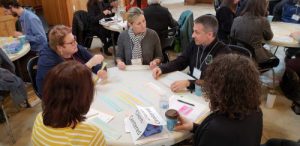 The second convening of the three-part ABLe Change Process took place February 20 and 21 at the Dawn Farm Community Barn in Ypsilanti. Roughly five-dozen participants from a range of substance use prevention and treatment programs attended, collaborating on an action plan to improve community wellbeing and reduce harm from substance use.
The second convening of the three-part ABLe Change Process took place February 20 and 21 at the Dawn Farm Community Barn in Ypsilanti. Roughly five-dozen participants from a range of substance use prevention and treatment programs attended, collaborating on an action plan to improve community wellbeing and reduce harm from substance use.
During the first ABLe Change convening in November 2018, three-dozen participants reviewed data to inform a shared vision, identified metrics that could be tracked to evaluate progress, and discussed the additional data and perspectives required to develop an effective action plan.
Over the next few months, staff and stakeholders reached out to active substance users, and those in recovery, to gather missing perspectives. They also surveyed practitioners, funders, community leaders, direct service providers, and the family and friends of users.
Anonymized feedback from these surveys was analyzed on the first day of the second convening, which tasked participants with identifying common themes related to root causes in the community. Participants then broke into groups to discuss shared values that should be influencing the substance use prevention, treatment, and support system—things like the importance of continuous learning, the perspectives of active users, and more.
 Groups then discussed each phase of the substance use response system, and barriers that prevent its ideal functioning. How you identify someone with a substance use need? How do you determine which treatment would serve them best? And how do you go on to support them through recovery?
Groups then discussed each phase of the substance use response system, and barriers that prevent its ideal functioning. How you identify someone with a substance use need? How do you determine which treatment would serve them best? And how do you go on to support them through recovery?
In each of these phases, barriers prevent an optimal system. Each organization uses a different substance use screening tool, for example, and because they don’t share information, users are forced to complete multiple assessments each time they seek treatment at a new organization.
Participants looked at these data points, learned how to identify root causes, and learned how to select strategic targets for systems change. “Ultimately we want to change systems, policies, and mindsets—not just programs and services,” says Carrie Rheingans, Washtenaw Health Initiative and Community Engagement Project Manager at the Center for Health, Research, and Transformation (CHRT).
Carrie’s group, for example, focused on eradicating stigma. “It may not happen for decades, but we wanted to look at root causes for stigma—like the fact that people view substance use as a moral failing, not a disease—and how we can get people to change that mindset,” she says.
On day two, participants began to suggest things that could be done to address root causes. And between now and May, when the final ABLe Change convening will take place, participants will vet these ideas with a broad range of stakeholders, collecting feedback for the final convening.
At the May convening, groups will share their findings. Which systems change efforts resonated with stakeholders; which organizations might be interested in championing them; and which seemed problematic. Then they’ll collaborate on an action plan, including what to do, how to fund it, and how to see it through.
